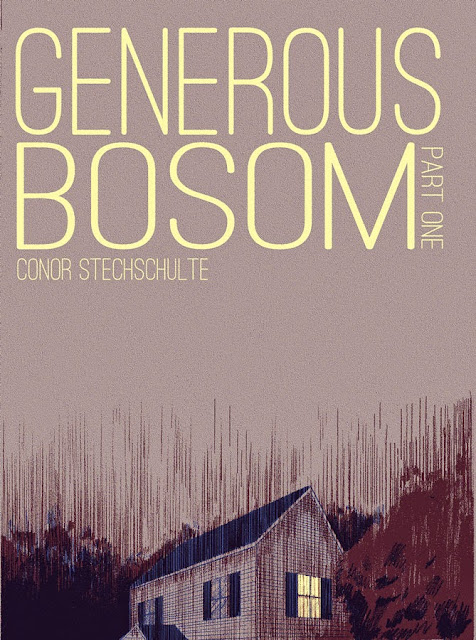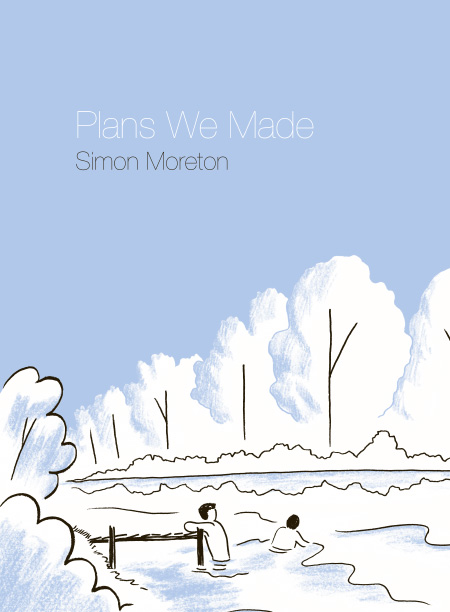Quick Reviews of Two Books you may be interested in.
PLANS WE MADE by Simon Moreton
Published by Uncivilized Books
Sometimes you really need to step back and listen to the quiet. In the silence, sporadically, the loudest admonitions can be heard. “Go forth.” “Conquer.” “Be afraid.” “You are in love.” -- such are the sounds reverberating in the hush. Artists who can make the most of silence, pauses, lulls in the frenetic pace of the day-to-day, often deal in that which we most need to hear.
So it is with Simon Moreton’s Plans We Made. Here is a book saturated with those in-between moments that occur between thought and expression (wherein, as Lou Reed reminded us, lies a lifetime). His simple lines coalesce into each juncture, uncomplicated and absolute, conveying all that the mind conjures -- be it joy, disappointment, or confusion -- as steps are taken from here to there.
Plans We Made is about looking back. Moreton is remembering youth and longing, capturing those liminal instances of what might be possible in the next moment. While specifically exploring his British and suburban experiences, Moreton, through his minimalism and erasure, transcends that which is individual and broadens his reach to the universal.
Longing is a human construct that is saturated with hope. It is the wellspring from which arises disappointment as much as it slakes desire. Within all discontent comes the impetus for change. Morton takes this all apart in Plans We Made through narrative, through pace, but mostly through his simple lines and layouts. In Morton’s pages, forms are dissolved into naked shapes through which the reader makes meaning, attempts closure, overlays the self. Here, what is less becomes more; the silence echoes reflections like a placid lake seen from above. Each moment is about that which is unsaid and undrawn; it leads to the cacophony of silence and an emotional center that holds tight insomuch as it becomes universal.

There is solace in solitude as there is beauty in simplicity. Moreton masters the lyrics to this song. In each of its pages, Plans We Made sings softly that which could have been, quietly humming a backbeat of instances of regret and of unadulterated joy, paring it down to the shadowline between substance and articulation.
This, my friends, is a beautiful book.
Plans We Made is available through Minneapolis publisher Uncivilized Books here.
INKBRICK: A JOURNAL OF COMICS POETRY Volume 4
The possibilities of what is termed Comics Poetry continues to fascinate me, intersecting, as it does, so much of what I use to define myself and the world around me. Alexander Rothman, Paul K. Tunis, and Alexey Sokolin, the editors of InkBrick: A Journal of Comics Poetry, keep pushing the genre(?) to the forefront, gathering the wheat into their barn, as it were, and burning the chaff with the unquenchable fire of omission.
I’ve written quite a bit about this anthology in the past (see here and here), trying to understand how this hybrid form functions and what new sensibilities it brings to the table. I’ve loved and lauded what Rothman et al. are attempting and producing with each issue. Volume 4 continues my unpacking and pasting on the wall, but with just a little less enthusiasm than before.
Maybe it’s me. Maybe it’s when the shiny new begins to tarnish with use.
Don’t get me wrong, though, there are many spectacular pieces in this issue. My favorite piece is “Eight Bells” by Alexey Sokolin and Angel Chen which uses both an evocative pastiche of nautical imagery along with a poem presented with its sentences diagrammed in the traditional grammarian’s method (such stuff sings in my heart and soul). There is strength in the visual acknowledgement of how the words of each sentence bind to each other, their function flowing into form, hinging upon each other -- diagramming in this manner expresses the mathematics of language, gives added pauses to the work of each word. The poem here cascades and the art floats along with this conceit. Here the poetry throbs with a tighter heartbeat because of its intersections with the visual plane.
Another addition to InkBrick 4 that maximizes the possibilities of comics poetry is “August in Pasikuda” by Isuri Merenchi Hewage and Deshan Tennekoon. In this piece, panels are overlaid on intricately detailed watercolor and ink backgrounds (abstracted and awash in color) giving the illusion of sequence, of story. Sporadically placed, the words inhabit corners, giving breath and life to their meaning. On its own, the art performs one story, the words another. Together, though, they create something beautiful, they create comics poetry.

But the fourth volume of this anthology stumbles a bit in its overall cohesion to its intent. While the idea of comics poetry is expansive, there have to be some agreed upon guidelines and, in this volume, there are a few pieces that just step outside the wide circle. Not that they aren’t interesting in their own right, but are they comics poetry if they are wordless or only have one word? Where do you draw the line? If everything is comics poetry then why make the distinction at all?
For me, the decision by the editors to expand the scope of what they include weakens the overall sensibility of InkBrick. Compared to the previous issues, Volume 4 feels watered down, as if it was rushed to print or subject to late night editorial boozing.
Still, InkBrick is the go-to for what is happening in the world of comics poetry. It is overall a spectacular world, more than worthy of a journey.
You can pick up a copy of InkBrick: A Journal of Comics Poetry Number 4 here.


































